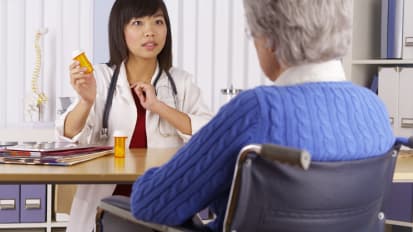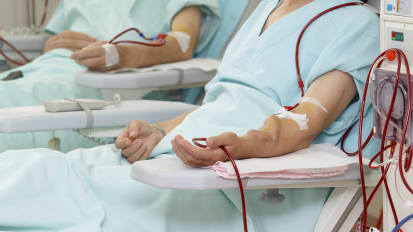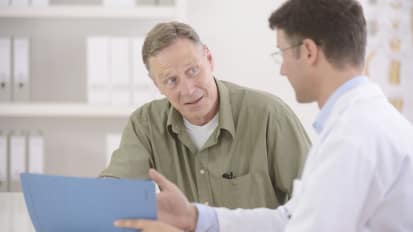Chapters
Transcript
CHAD ABBOTT: How many people are aware of paired kidney donation? OK, so the majority of people have at least heard of it. I'm just going to talk real briefly of why we do it, and then I'll get us into exactly what it is. So you know all of this stuff, the number of people on the waiting list keeps increasing, living donor transplants have remained stagnant if not decreased in recent years, and deceased donor transplants will never meet the need. So, this is actually a question, see who can answer, who can give me the correct answer is what I'm trying to say.
[AUDIENCE ANSWERING]
How many say B? How many say C? All right, many Sparties are in the room? OK, B is the correct answer, C is the big house, D is Spartan stadium. I did this talk in Lansing so, that's the reason for that one. I apologize. OK, I'm going to go through this really quickly, these are in your slides, this just shows the number of people that are added to the waiting list. So you can see, more than 30,000 people are added on an annual basis. This shows the number of people that are currently on the transplant list. There's the number of transplants we do so, out of all donors, so we add about 35,000, we do about 17,000, which is why we know only about 50% of the people ever put on a waiting list get transplanted. Again, this just shows some recent numbers, so if you look at this, the living donors, that's a little disturbing you can see it's actually went down, and I'll talk a little bit of why we think living donation is went down.
Again, this is just another slide that shows the transplants, and the waiting list additions in red, compared to the transplants in blue. So, reasons that we think living donation has decreased. Increase regulatory oversight, I think that's a good thing, but we are required to do even more than when we started 10 years ago with living donors. The recipient population continues to age. So, in 1998, you can see only about 8% of the people were 65 or older, in 2011, this is a little bit old, it was 17%. My guess is it's probably over 20% now, so they have a decreased network of potential donors, and we find a lot of elderly people who may be not real open to asking somebody, particularly somebody younger, to donate a kidney for them. We all know the general population health continues to worsen, we see increased rates of diabetes, and high blood pressure. We screen a lot of donors that we find high blood pressure and diabetes in, which ends up being good for them but, it means they can't donate.
There is a financial disincentive to donate. Anybody that comes forward to donate a kidney, it costs them something. Whether it's the price of gas to get here, travel, lodging. There are some really good programs out there that will help offset costs. One thing when I talk with recipients, I try to tell them there are programs out there that we can try to obtain to help living donors pay for expenses. To date there isn't anything that will cover lost wages, although there is a study that hopefully we're going to be able to participate in, which is being sponsored by the American Society of Transplant Surgeons, that is going to look at reimbursing for lost wages up to $3,000. So there's a lot of things out there, but nothing is concrete yet. Sensitized patients, these are people that have high levels of anti-bodies. I'm not going to spend a lot of time on this, a lot of our population is what we call sensitized. About 30% of the list. So, what can we do? There's a Jim Harbaugh quote you can look at that in your slides.
OK paired kidney donation. We have a lot of donors that come forward that don't match the recipient. Either because the blood type is incompatible, or the cross match is incompatible because they're sensitized. So the basic premise of it is really easy. You have donor A, recipient A, donor B, recipient B, and you swap them. Very rarely does it work that way. To date, we have now transplanted 103 people, we did our 103rd last week. First internal one was in 2008. The first alliance for paired donation match was in 2009, and the United Network for Organ Sharing started their program a couple of years ago, and our first one was in '15.
This past September, we did an international KPD case that was generated through the Alliance for paired donation. So, a Filipino donor and recipient came here, it was two sisters, one sister needed the kidney, one donated for the other person. We did a case with a Mexican donor and recipient just this past month. So it has really broadened, and started to go global. Those have both been generated through the Alliance for Paired Donation.
Today this just shows you the split of where we've generated our matches. The majority of our initial ones at U of M came when we were doing them just internally. We stopped that about three years ago because we can generate matches through the Alliance for Paired Donation.
So this just shows you all of the centers, and actually we've worked with more centers than this now. The nice thing about paired donation is A, you get to network with a lot of people and we can bounce stuff off of each other and say, we do it this way, we do it that way, so I think we've learned a lot. Another thing is that a lot of people who are hard to match, it can be really difficult to find them a match in our local area. If you think about populations, where you live is generally, it's the same set of people, which means a lot of the genetic typing is the same. The population here's genetic typing is totally different than it is in California, which is why a lot of our difficult to match people had received transplants from the West coast, just because it's a different population. It's the same thing in paired donation, we may not be able to match somebody here, but we can match them at an outside center.
So who can benefit? Pretty much anybody can benefit. This is the big message that we try to tell our people, and when you talk to recipients if you can tell them, it doesn't matter what the blood type is, it doesn't matter what the relationship is. The message is, any potential donor is a good donor.
Compatible paired donation is something that we have started doing. We have a lot of people that may not be related, and they're ready to be scheduled, and we'll ask them, are you open to going into paired donation and benefiting from somebody else. Some people are all for it, some people are like, no I came here to donate to this person that's who I want to donate to. An example of where this was beneficial, or what we think was probably beneficial to a compatible recipient, you can see we had the 55-year-old was going to donate to the 25-year-old. They were all for paired donation, the 25-year-old ended up getting a 26-year-old kidney, and somebody else benefited. So this is just another idea that shows things that we've done that tried to increase organ donation.
There are a lot of barriers in KPD. We still find donors that are unwilling to participate, this is not nearly as profound as it used to be, but we still do find people saying, oh I want to donate to this person. Usually when we explain, OK your person is getting a kidney, you're not going to donate unless they get a kidney, or have already received one, then they're open to it. I mentioned the majority of the people are sensitized impaired donation. You deal with real people with real life events in paired donation, these are all people who obviously have an illness.
An example, we had one scheduled last year that was four donors, four recipients, four centers across the whole United States, and our donor got tackled by a dog, at a party, for the recipient, the week before and fractured her back. So everything went away, and those things happen. We deal a lot of times where you may have a surgery scheduled, and a recipient gets ill, and you can't do it. I mentioned that the donor never donates until the recipient either gets the kidney, or is getting it on the same day.
There's one scenario where we didn't do that. We did it a couple of months ago, and if you want to see a really neat guy, he's our recipient. Google operation scissor gate, and just read his story. It is amazing what this guy does. He's, I don't know how old he is, he's probably in his 30's, but anyway, he was born with prune belly syndrome. Does a lot of volunteer work. Him and his best friend were scheduled in a paired donation match, and Marty, that's the recipient, got the flu. So again it was going to stop like six transplants this time, and his donor was all for just, he's like, I want to do it, I'm going to do it, we had the conversation. Marty may not get this, he may not be well enough, something could happen with the donor. They ended up being all for it he did it, and then Marty got an ear infection, so two months later he got his kidney. But that is not typically how you do it. My reason for bringing that up is, I think recipients worry a lot about that. What am I going to get out of this if my donor donates, and the answer is you're going to get something at the same time.
Logistics, you're dealing with centers across the United States, you're dealing with time zone issues. We're pretty good at it now, the way it works is we as coordinators usually talk in the morning before the surgery starts. We won't start our OR here until I've confirmed, yes you're able to go. The last thing you want to do is take a kidney out of a donor, and not have a recipient to put it into. Which is why you have that communication. We deal with the time zone issues. California, we've done four or five with California, they usually do theirs at night, and it flies on the red eye overnight, and then we start it. The kidneys are couriered, but they fly commercial. So they fly on Delta.
[AUDIENCE LAUGHING]
So what we've learned. NEAD chains. That acronym stands for never ending altruistic donor. We have had a lot of people at our center that have came forward. These are just people that want to donate a kidney. There's at least four or five right now that have started active chains. So we had a lady who donated last summer, the last I looked, 16 people had benefited as a result of her single donation. The benefit has went nationwide. A lot of times, we end up with what are called bridge donors in that scenario. Where let's say, I donate to Colleen with the idea that Colleen's husband is going to donate in the future. He can back out, I mean that's a realistic thing, that's why we try to have them all set up and scheduled. And we haven't had that happen in at least three or four years.
Other things that we have learned is talking with the donors and recipients upfront increases their knowledge and understanding. We, as transplant coordinators, have started going in and meeting with every recipient now at their initial evaluation. Even if we spend at least five minutes we can get across some of this basic stuff. I think that, it has definitely helped in the number of donor calls that we get. Unfortunately, it hasn't translated into increased transplants because our numbers have not went up, but at least the people are calling. Again, the message that any potential donor, is a good donor, just increases the awareness. And then people think outside of the box. I think a lot of times people think it has to be my family, it doesn't have to be your family. We did a program earlier this year called donor champion. Helping people look at ways to network themselves, and get the word out. If any of you have people who you know that have struggled with looking for donors, give me a call, and I'm happy to call and just talk to them about different ideas.
That's the example of the donor that I just mentioned that's now benefited 16 people.
This is a pretty cool deal where it was the first paired exchange with centers from Michigan. So, you can see, that's Dave and Tricia on our left, and then in the middle we have Henry Ford, and then on the right we have Beaumont. So that was a pretty cool story. All of them started simultaneously, went on the same day, and then we all met down at Henry Ford, and channel 4 did a story on them. There's a lot of stuff out there like that, but again, the more that you can talk to your recipients about different options for transplant, the better, because we know what we're doing isn't filling the need.
Yes?
AUDIENCE: Is this legally complicated, and if not how do you apply that? Is there a contract that you sign?
So, legally, to enroll anybody in paired donation, it's a separate consent, and a separate release of information. Because your information is traveling from center to center. That covers that. As far as the cost, the Alliance for Paired Donation has it all set up that there's a standard acquisition fee. It's actually very easy, so it really that hasn't been an issue.
Chad Abbott, RN, CCTC, brings awareness to Living Kidney Donation and the current downward trend in the number of potential donors. Learn what is contributing to this downward trend and what may be done to reverse the trend and help patients.
This presentation is part of the education event “A Patient’s Journey through Kidney Transplantation.”
To learn more, click here.
Related Videos





